|
Risk - Legacy/Risiko -Evolution
Author: Rob Daviau
Publisher: Hasbro/Heidelberger Spieleverlag
Year: 2011
review by

| x |
|
|
|
|
|
|
|
|
|
|
|
|
|
|
|
|
|
|
|
|
|
|
|
|
|
|
|
|
|
|
|
|
|
|
|
|
|
|
|
|
|
|
|
|
|
|
|
|
|
|
|
|
|
|
|
|
|
|
|
|
|
|
 |
It may not quite be the spot to write an essay about the development of a player when the outcome of it already is known; it is like watching a recorded sports game of which the results are cheered through the walls beforehand.
|
|
|
|
|
| x |
|
|
|
|
|
|
|
|
|
|
|
|
|
|
|
|
|
|
|
|
|
|
|
|
|
|
|
|
|
|
|
|
|
|
|
|
|
|
|
|
|
|
|
|
|
|
|
|
|
|
|
|
|
|
|
|
|
|
|
|
|
|
|
The whole classic scope among which ‘Monopoly’ has gone through during childhood to finally arrive at ‘Stratego’, from which point the games landscape further was explored with ‘Ballonrennen’, ‘Oil: the Great Adventure/Öl für uns Alle’, ‘Hare & Tortoise/Hase und Igel’, ‘Broker/Das Börsenspiel’ and ‘Jockey’, not quite accidental all from Ravensburger that in the seventies had quite a strong position on the board games market. MB and the Dutch Clipper mostly published licensed games that were of lower quality, both in execution as in playability: the completely lack of tactics in ‘Tank Battle’, the lame rules of ‘Colditz’, the bland ‘Long Course/Käpt’n und Pirat’ and the unbalanced ‘Embuscades!’. And then Clipper published a new version of ‘Risk’...
|
|
|
|
|
| x |
|
|
|
|
|
|
|
|
|
|
|
|
|
|
|
|
|
|
|
|
|
|
|
|
|
|
|
|
|
|
|
|
|
|
|
|
|
|
|
|
|
|
|
|
|
|
|
|
|
|
|
|
|
|
|
|
|
|
|
|
|
|
Evenings and nights were spent with this board game, here was a concept that appealed to a boy’s feeling: encounter adventures and waging wars! The adventure was that each player was dealt a secret mission card at the start of the game; he had to conquer specific continents or areas on the board in order to win, or eliminate one other player. If there was anyone in the way sooner or later but inevitably a battle was fought that could earn a player a card that could be collected and exchanged for new armies. Playing ‘Risk’ was the new rage among friends, but also the whole family, father and mother included, played it enthusiastically. It even got a house rule: when turning in a set of cards the armies on the areas of those cards where nuked away with little tactical implications as now every player kept the cards of the areas where his own armies stood. Dice rolled and rolled until a new genre of games was discovered: the wargame.
With ‘Squad Leader’, ‘Anzio’, ‘Midway’, ‘Panzer Leader’ and ‘Afrika Korps’ more than ten games were played simultaneously, most of them by mail with gamers from all over the world - are you still there Jack Jewart? Wally Zenkteler? John R. Kelley?
The ‘normal’ board game was pushed to the background temporarily but for years until the board game started on a renewed and untranslated - because German - march; they were directly acquired at the ‘Spiel!’ fair in Essen. The tactics of these games perhaps was less, but the fun to sit around the table with friends and being able to play one or more games in one single evening, instead of completing them in a correspondence of over three years and more, made the difference. ‘El Grande’, ‘Puerto Rico’ and ‘Euphrat & Tigris/Tigris & Euphrates’ were the first favorites. Games were played, there was much laughter, and each new game was eagerly looked forward to. And then there was ‘Risiko - Evolution/Risk - Legacy’... |
|
|
|
|
| x |
|
|
|
|
|
|
|
|
|
|
|
|
|
|
|
|
|
|
|
|
|
|
|
|
|
|
|
|
|
|
|
|
|
|
|
|
|
|
|
|
|
|
|
|
|
|
|
|
|
|
|
|
|
|
|
|
|
|
|
|
|
|
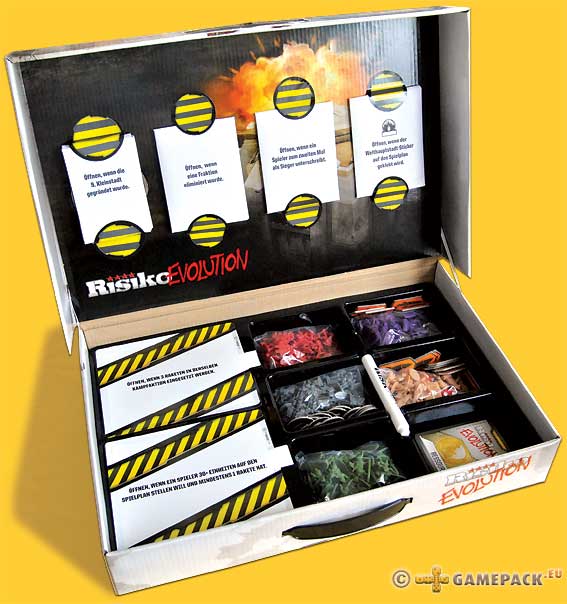 |
The text on the box, in the form of an attaché-case, challenges the players: a game will be played, but a game that gradually changes by the interventions and decisions of the players. Winners may found cities, territories can be protected. And the game includes sealed envelopes. What could be inside? How is the game played anyway? Will there still be something recognizable left of the ‘old’ ‘Risk’? And: will this version be challenging enough to play the game more or less again?
|
|
|
|
|
| x |
|
|
|
|
|
|
|
|
|
|
|
|
|
|
|
|
|
|
|
|
|
|
|
|
|
|
|
|
|
|
|
|
|
|
|
|
|
|
|
|
|
|
|
|
|
|
|
|
|
|
|
|
|
|
|
|
|
|
|
|
|
|
|
When the suitcase is opened, the four sealed envelopes in the lid attract immediate attention. On them are the various conditions under which they may be opened: when the first player has won twice; when the ninth city has been founded, when a player is eliminated from the game, or when the world capital has been founded. In the box, next to the playing pieces are two larger pockets, also sealed, that require similar conditions: when a player wants to place at least 30 armies on the board and possesses at least one missile, or when an attack has been supported by three missiles. Missiles? Doesn’t this sound a bit like the old house rule? The curiosity is aroused!
|
|
|
|
|
|
|
| x |
|
|
|
|
|
|
|
|
|
|
|
|
|
|
|
|
|
|
|
|
|
|
|
|
|
|
|
|
|
|
|
|
|
|
|
|
|
|
|
|
|
|
|
|
|
|
|
|
|
|
|
|
|
|
|
|
|
|
|
|
|
|
|
The game board shows the familiar world map in a contemporary look; all continents have the same division in territories as previous versions of ‘Risk’. The armies are miniatures and each faction is different shaped. ‘I play with red!’ is the first mistake a player could make when the game has not yet been explained to him; players choose a faction with its own characteristics and capabilities. The first player may choose one of the five factions - and that faction comes with a specific colour. Before the first game each faction receives one starting specification attached, chosen from two possible ones - the other is removed from the game and can be destroyed, it doesn’t come into play. The second change is evenly getting used to: each player, one by one, chooses his starting territory; putting all his armies there, and his headquarters. The territory cards are stil there but play a somewhat different role.
|
|
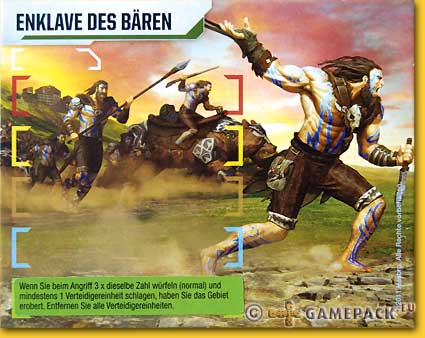 |
|
|
|
|
| x |
|
|
|
|
|
|
|
|
|
|
|
|
|
|
|
|
|
|
|
|
|
|
|
|
|
|
|
|
|
|
|
|
|
|
|
|
|
|
|
|
|
|
|
|
|
|
|
|
|
|
|
|
|
|
|
|
|
|
|
|
|
|
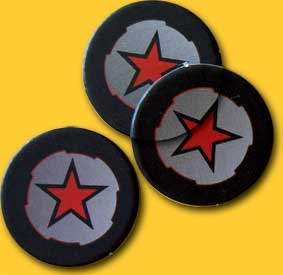 |
|
The headquarters is important in accomplishing the goal of the game: be the first to have four stars, where a headquarters counts as one star so in fact a player already has collected his first star for free.
This way, players start on a board that for the most part is unoccupied territory. There is no need to attack such territories; a player may invade it with his army and proceed to others, as long as he leaves at least one army in the occupied territory. There will be almost no fighting during the first turns when almost the whole board gets occupied by armies and the smaller continents such as Australia and South America are taken with ease and without resistance.
|
|
|
|
|
|
|
| x |
|
|
|
|
|
|
|
|
|
|
|
|
|
|
|
|
|
|
|
|
|
|
|
|
|
|
|
|
|
|
|
|
|
|
|
|
|
|
|
|
|
|
|
|
|
|
|
|
|
|
|
|
|
|
|
|
|
|
|
|
|
|
|
At the start of each turn a player receives the standard armies for the territories he occupies, divided by three, with a minimum of three - at least something familiar remains. Also the bonus armies for occupying a whole continent is the same; a player who at the start of his turn occupies all territories of Australia receives 2 extra armies that he may place on any territory he already occupies.
|
|
|
|
|
|
|
| x |
|
|
|
|
|
|
|
|
|
|
|
|
|
|
|
|
|
|
|
|
|
|
|
|
|
|
|
|
|
|
|
|
|
|
|
|
|
|
|
|
|
|
|
|
|
|
|
|
|
|
|
|
|
|
|
|
|
|
|
|
|
|
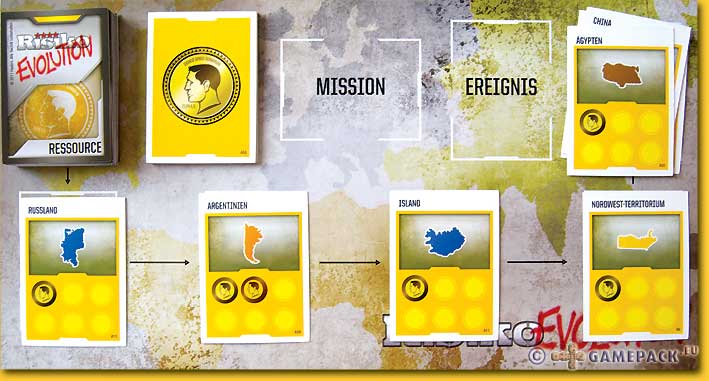 |
|
|
|
|
| x |
|
|
|
|
|
|
|
|
|
|
|
|
|
|
|
|
|
|
|
|
|
|
|
|
|
|
|
|
|
|
|
|
|
|
|
|
|
|
|
|
|
|
|
|
|
|
|
|
|
|
|
|
|
|
|
|
|
|
|
|
|
|
| Next to the game board a smaller board is placed with the blind deck of territory cards; of these, four are drawn and placed open; all cards show a coin, some of them already two or even three, but with a maximum of six. When a player was succesful in at least one attack during his turn, he takes one card from the display if this is a territory card. All territory cards left from the now empty space are moved one space to the right and a new territory card is drawn. If there were no eligible territory cards to take, he takes one general coin card instead and discards the fourth territory card. |
|
|
|
|
|
|
| x |
|
|
|
|
|
|
|
|
|
|
|
|
|
|
|
|
|
|
|
|
|
|
|
|
|
|
|
|
|
|
|
|
|
|
|
|
|
|
|
|
|
|
|
|
|
|
|
|
|
|
|
|
|
|
|
|
|
|
|
|
|
|
|
The coins on the territory cards can be collected just like the symbols infantry, artillery and cavalry in the classical ‘Risk’. At the start of his turn, a player may opt to turn in any number of coins - minimum 2 - and exchange them for armies.
|
|
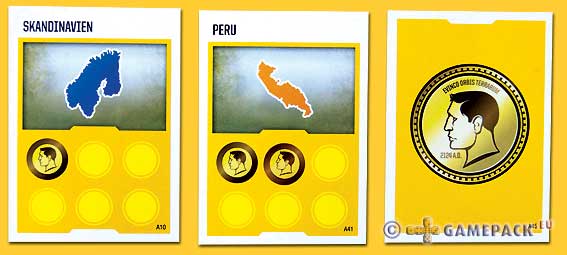 |
|
|
|
| x |
|
|
|
|
|
|
|
|
|
|
|
|
|
|
|
|
|
|
|
|
|
|
|
|
|
|
|
|
|
|
|
|
|
|
|
|
|
|
|
|
|
|
|
|
|
|
|
|
|
|
|
|
|
|
|
|
|
|
|
|
|
|
|
Two coins earns two armies, three coins four, and the player turning in 10 coins may exchange it for 30 armies - Ah! Thirty armies! Wasn’t there a seal that was allowed to be broken somewhere? Mmh, missiles needed, we’ll have to wait a bit.
|
|
|
|
|
|
|
| x |
|
|
|
|
|
|
|
|
|
|
|
|
|
|
|
|
|
|
|
|
|
|
|
|
|
|
|
|
|
|
|
|
|
|
|
|
|
|
|
|
|
|
|
|
|
|
|
|
|
|
|
|
|
|
|
|
|
|
|
|
|
|
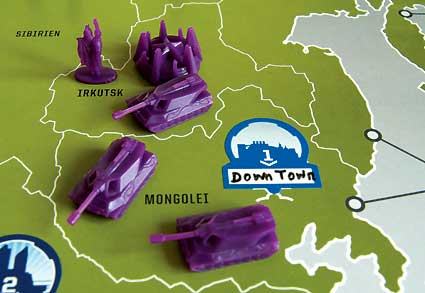 |
|
So four stars have to be collected? When playing with four players, those other three must be sought at their headquarters then? Not quite, as when turning in four territory cards - without claiming the armies for the coins – they may be exchanged for one star. And when the general stack of coin cards is depleted, the player with the most occupied territories at that moment may claim a star too. Furthermore, each player who did not win any game of ‘Risk – Legacy’ so far, starts with a star. This way all players start with one HQ and a star, only having to collect two stars in the first game! Easy does it! The rules state further that in future games, other ways to earn stars lie ahead - and this all again is concealed in those little envelopes!
|
|
|
|
|
|
|
| x |
|
|
|
|
|
|
|
|
|
|
|
|
|
|
|
|
|
|
|
|
|
|
|
|
|
|
|
|
|
|
|
|
|
|
|
|
|
|
|
|
|
|
|
|
|
|
|
|
|
|
|
|
|
|
|
|
|
|
|
|
|
|
| During the course of one or more games, some territories are more easy or more difficult to conquer or defend. Again at the start of the game each player receives a socalled scar card, but only if there are enough to be dealt one to each player. These are sticker cards with either a bunker or a missile prohibition sign. A player may play such a card/sticker on a stated time and stick it on any one territory. The bunker increases the highest die roll of a defender with ‘1’, while the missile prohibition sticker decreases the highest roll of the defender by ‘1’. Each territory can have only one scar. The rules mention that gradually more scar cards come into play. This makes everything the more exciting; in which to be opened sealed envelope could we find them? |
|
 |
|
|
|
|
| x |
|
|
|
|
|
|
|
|
|
|
|
|
|
|
|
|
|
|
|
|
|
|
|
|
|
|
|
|
|
|
|
|
|
|
|
|
|
|
|
|
|
|
|
|
|
|
|
|
|
|
|
|
|
|
|
|
|
|
|
|
|
|
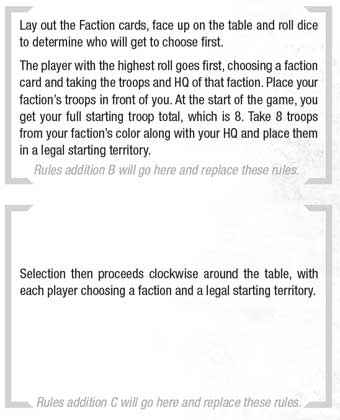 |
|
By the way, the rules, they are by far not complete! On several pages we find empty white spots! Here we find gray printed cryptic descriptions such as ‘Rules addition H will go here’. The players are informed that at these spots, at a later time, during or after a game, additional rules come into effect. And these also come under specific conditions from one of these sealed little envelopes or pockets. Let’s continue play! Yet another game!
|
|
|
|
|
|
|
| x |
|
|
|
|
|
|
|
|
|
|
|
|
|
|
|
|
|
|
|
|
|
|
|
|
|
|
|
|
|
|
|
|
|
|
|
|
|
|
|
|
|
|
|
|
|
|
|
|
|
|
|
|
|
|
|
|
|
|
|
|
|
|
|
At any given moment a player has collected his fourth star and thus has won. The winner now has various options: he may found a major city and stick the appropriate sticker in any chosen territory on the board, he may cancel a scar, name a continent, change the continent bonus, fortify a city, or destroy a territory card. Wah! Tear it apart? But this is my game!
The other players are given some options to perform too: found a minor city, or upgrade a territory card by sticking an additional coin on it. The territory cards can hold up to six coins and because of this growing potentential they have in receiving armies and the threat they may pose at a given time, any player who thinks they have become too strong will certainly not hesitate and opt for destroying the card.
|
|
 |
|
|
|
|
| x |
|
|
|
|
|
|
|
|
|
|
|
|
|
|
|
|
|
|
|
|
|
|
|
|
|
|
|
|
|
|
|
|
|
|
|
|
|
|
|
|
|
|
|
|
|
|
|
|
|
|
|
|
|
|
|
|
|
|
|
|
|
|
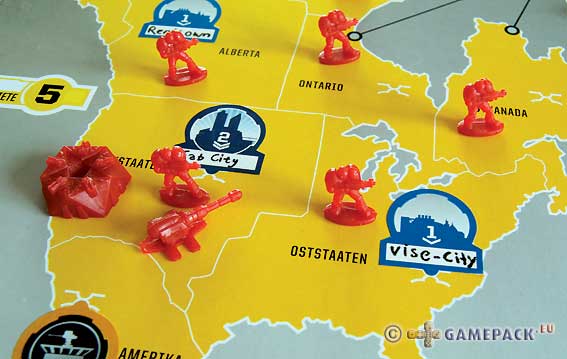 |
|
By founding a major city a player is allowed to start future games in this city; the rules normally exclude stickered territories as starting areas. Besides this a major city has a population of ‘2’ and a minor city of ‘1’ that may be added to the amount of territories when calculating the reinforcements at the start of a player’s turn. When an empty territory with a city is invaded, losses must be taken equal to the size of the population in that city.
|
|
|
|
|
|
| x |
|
|
|
|
|
|
|
|
|
|
|
|
|
|
|
|
|
|
|
|
|
|
|
|
|
|
|
|
|
|
|
|
|
|
|
|
|
|
|
|
|
|
|
|
|
|
|
|
|
|
|
|
|
|
|
|
|
|
|
|
|
|
| When the winner names a continent, he recieves a bonus of one army in each turn and any following game when he completely controls that continent. |
|
|
|
|
|
|
| x |
|
|
|
|
|
|
|
|
|
|
|
|
|
|
|
|
|
|
|
|
|
|
|
|
|
|
|
|
|
|
|
|
|
|
|
|
|
|
|
|
|
|
|
|
|
|
|
|
|
|
|
|
|
|
|
|
|
|
|
|
|
|
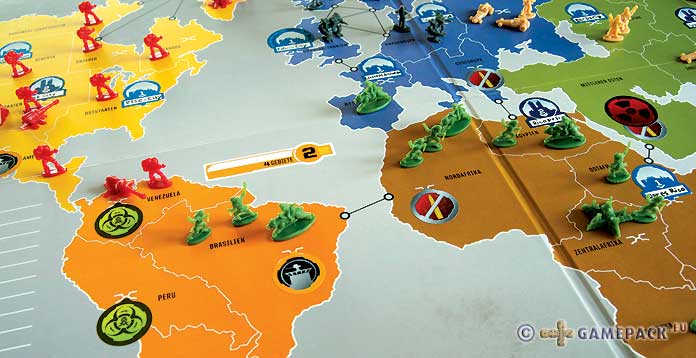 |
|
|
|
|
| x |
|
|
|
|
|
|
|
|
|
|
|
|
|
|
|
|
|
|
|
|
|
|
|
|
|
|
|
|
|
|
|
|
|
|
|
|
|
|
|
|
|
|
|
|
|
|
|
|
|
|
|
|
|
|
|
|
|
|
|
|
|
|
|
And so the board gradually gets filled with bunkers, missile prohibition stickers and cities, with limited possibilities for starting territories with each subsequent game. And maybe some territories become more attractive than others because of the displayed territory cards and associated coins. The winner loses his extra star from now on, but may start the game with a missile, receiving one for each won game. He can play one or more missiles during a battle, even if he is not involved, and may play it after the dice are rolled. The missile increases any one die - attacker or defender - to a ‘6’ that cannot be modified,. An important battle can have a decisive twist when missiles are involved!
|
|
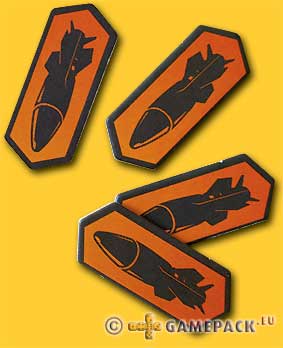 |
|
|
|
|
| x |
|
|
|
|
|
|
|
|
|
|
|
|
|
|
|
|
|
|
|
|
|
|
|
|
|
|
|
|
|
|
|
|
|
|
|
|
|
|
|
|
|
|
|
|
|
|
|
|
|
|
|
|
|
|
|
|
|
|
|
|
|
|
 |
|
Each player has written down his name on his faction card, together with his starting area. At the end of the game on this card is also noted if this faction has won or not, or if it has been completely wiped from the map or even eliminated without the possibility of returning back on the map - which are two different game conditions. Not being able to play is reduced to the minimum in ‘Risk - Legacy’, although it is a condition under which a sealed envelope may be opened. |
|
|
|
|
|
|
| x |
|
|
|
|
|
|
|
|
|
|
|
|
|
|
|
|
|
|
|
|
|
|
|
|
|
|
|
|
|
|
|
|
|
|
|
|
|
|
|
|
|
|
|
|
|
|
|
|
|
|
|
|
|
|
|
|
|
|
|
|
|
|
| But what exactly is inside these envelopes? In any case, event cards, and mission cards, as this is already mentioned in the ‘standard’ rules. And what else? Well, this is something that the Risk players have to find out for themselves, as on this spot no tips of veils are lifted, too bad! |
|
 |
|
|
|
| x |
|
|
|
|
|
|
|
|
|
|
|
|
|
|
|
|
|
|
|
|
|
|
|
|
|
|
|
|
|
|
|
|
|
|
|
|
|
|
|
|
|
|
|
|
|
|
|
|
|
|
|
|
|
|
|
|
|
|
|
|
|
|
 |
|
|
| x |
|
|
| x |
|
|
| x |
|
|
 |
|
|
|
|
|
|
|
|
|
|
|
|
|
|
|
|
|
|
|
|
|
|
|
|
|
|
|
|
|
|
|
|
|
|
|
|
|
|
|
|
|
|
|
|
|
|
|
|
|
|
|
|
|
|
Is this still the old ‘Risk’ as we know it? At least the board looks familiar, and the battles and moves are almost similar to the standard Risk game. And the territory cards are still there. But further? ‘Risk - Legacy’ is a totally new and renewed game, it’s like a freshly painted room: known from up to above and yet new in its appearance including new lighting, and instead of the old linocut there is a digital display with trendy and moody photo’s. It makes one wonder how this concept could work for other classic board games such as ‘Monopoly’, and see how such a game could evolve and grow through players decisions. It certainly could use some stickers and additional rules!
|
|
|
|
|
|
|
| x |
|
|
|
|
|
|
|
|
|
|
|
|
|
|
|
|
|
|
|
|
|
|
|
|
|
|
|
|
|
|
|
|
|
|
|
|
|
|
|
|
|
|
|
|
|
|
|
|
|
|
|
|
|
|
|
|
|
|
|
|
|
|
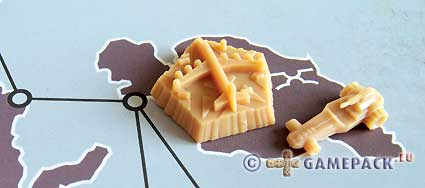 |
|
In the standard game game of ‘Risk’ players are each others opponents, and only seldom and then only for a very short time, each others allies. In ‘Risk - Legacy’ all players commit to a lengthy adventure, creating a high degree of involvement, and a clear incentive to quickly play the game again, especially during the first fifteen games when the board is not yet fully developed, the rules not complete, and when changes or enhancements still can take place.
|
|
|
|
|
|
|
| x |
|
|
|
|
|
|
|
|
|
|
|
|
|
|
|
|
|
|
|
|
|
|
|
|
|
|
|
|
|
|
|
|
|
|
|
|
|
|
|
|
|
|
|
|
|
|
|
|
|
|
|
|
|
|
|
|
|
|
|
|
|
|
|
The condition for opening the envelope when three missiles have been used in a battle can only be fulfilled early in the series of ‘Risk - Legacy’ when all owners of a missile express their desire to use them accordingly. It is fun to open an envelope or pocket, and all players are very involved when this happens. During these first fifteen games it is recommended to play with roughly the same group of players; otherwise some conditions may be triggered later than desired, slowing down the development of the game.
|
|
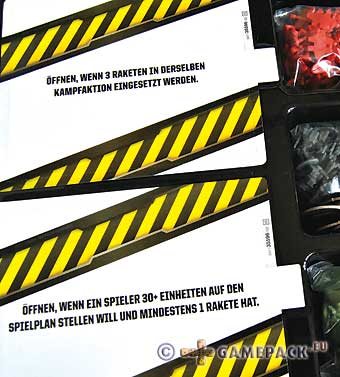 |
|
|
|
|
| x |
|
|
|
|
|
|
|
|
|
|
|
|
|
|
|
|
|
|
|
|
|
|
|
|
|
|
|
|
|
|
|
|
|
|
|
|
|
|
|
|
|
|
|
|
|
|
|
|
|
|
|
|
|
|
|
|
|
|
|
|
|
|
 |
|
Throwing away or shredding cards goes against the grain of any player and everybody will have some difficulty with it, but it is a logical consequence of the choices made and the development of the game. So it goes, and the game goes on - don’t look back!
|
|
|
|
|
|
|
| x |
|
|
|
|
|
|
|
|
|
|
|
|
|
|
|
|
|
|
|
|
|
|
|
|
|
|
|
|
|
|
|
|
|
|
|
|
|
|
|
|
|
|
|
|
|
|
|
|
|
|
|
|
|
|
|
|
|
|
|
|
|
|
| The game plays like a boys dream; it must have been developed by an afficionado of the ‘old’ ‘Risk’ who had lots of creativity. The game is an adventure where all players actively participate, and each new rule or otherwise added element brings an extra spark in the game: what fun! And yes, sometimes the dice roll not favorable, even and again in this version of the game. But they roll both ways, and each player will be lucky or unlucky at some point. This is inherent to the game system that now is decorated with all sorts of extras. The execution can be called excellent - although the stickers let loose a bit laborious, the supplied marker writes too thick and the game board is difficult to grab from the box - but what are we talking about. |
|
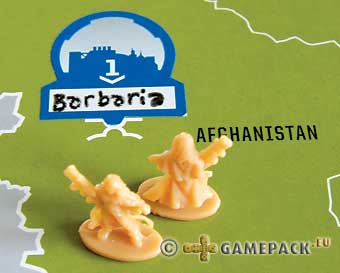 |
|
|
|
|
| x |
|
|
|
|
|
|
|
|
|
|
|
|
|
|
|
|
|
|
|
|
|
|
|
|
|
|
|
|
|
|
|
|
|
|
|
|
|
|
|
|
|
|
|
|
|
|
|
|
|
|
|
|
|
|
|
|
|
|
|
|
|
|
The game is an absolute must for anyone who thought that ‘Risk’ had become the wallflower of the school party - but look, she has changed into a seductive vamp!
The game wisely is recommended from 13 years and up; this goes against the trend to make all games accessible for youngsters and with a low level entry. ‘Risk - Legacy’ is for ‘real’ men, and, sometimes, women. But to survive in such an environment, they must not be afraid to occasionally act like a villain!
© 2012 Richard van Vugt
Risk -Legacy/Risiko - Evolution, Rob Daviau, Hasbro/Heidelberger Spieleverlag, 2011 - 3 to 5 players, 13 years and up, 60-90 minutes
|
|
|
|
|
|
|
  |
|
|
|
|
|
|
|
|
|
|
|
|
|
|
|
|
|
|
|
|
|
|
|
|
|
|
|
|
|
|
|
|
|
|
|
|
|
|
|
|
|
|
|
|
|
|
|
|
|
|
|
|
|
  |
|
|
|
|
|
|
|
|
|
|
|
|
|
|
|
|
|
|
|
|
|
|
|
|
|
|
|
|
|
|
|
|
|
|
|
|
|
|
|
|
|
|
|
|
|
|
|
|
|
|
|
|
|
  |
|
|
|
|
|
|
|
|
|
|
|
|
|
|
|
|
|
|
|
|
|
|
|
|
|
|
|
|
|
|
|
|
|
|
|
|
|
|
|
|
|
|
|
|
|
|
|
|
|
|
|
|
|
  |
|
|
|
|
|
|
|
|
|
|
|
|
|
|
|
|
|
|
|
|
|
|
|
|
|
|
|
|
|
|
|
|
|
|
|
|
|
|
|
|
|
|
|
|
|
|
|
|
|
|
|
|
|
| x |
|
|
|
|
|
|
|
|
|
|
|
|
|
|
|
|
|
|
|
|
|
|
|
|
|
|
|
|
|
|
|
|
|
|
|
|
|
|
|
|
|
|
|
|
|
|
|
|
|
|
|
|
|
|
|
|
|
|
|
|
|
|
| x |
|
|
|
|
|
|
|
|
|
|
|
|
|
|
|
|
|
|
|
|
|
|
|
|
|
|
|
|
|
|
|
|
|
|
|
|
|
|
|
|
|
|
|
|
|
|
|
|
|
|
|
|
|
|
|
|
|
|
|
|
|
|
 |
|
|
|
|
|
|
|
|
|
|
|
|
|
|
|
|
|
|
|
|
|
|
|
|
|
|
|
|
|
|
|
|
|
|
|
|
|
|
|
|
|
|
|
|
|
|
|
|
|
|
|
|
|
 |
|
|
|
|
|
|
|
|
|
|
|
|
|
|
|
|
|
|
|
|
|
|
|
|
|
|
|
|
|
|
|
|
|
|
|
|
|
|
|
|
|
|
|
|
|
|
|
|
|
|
|
|
|
| x |
|
|
|
|
|
|
|
|
|
|
|
|
|
|
|
|
|
|
|
|
|
|
|
|
|
|
|
|
|
|
|
|
|
|
|
|
|
|
|
|
|
|
|
|
|
|
|
|
|
|
|
|
|
|
|
|
|
|
|
|
|
|
 |
|
|
|
|
|
|
|
|
|
|
|
|
|
|
|
|
|
|
|
|
|
|
|
|
|
|
|
|
|
|
|
|
|
|
|
|
|
|
|
|
|
|
|
 |
|
|
|
|
|
|
|
|
|
|
|
|
|
|
|
|
|
|
|
|
|
|
|
|
|
|
|
|
|
|
|
|
|
|
|
|
|
|
|
|
|
|
|
|
|